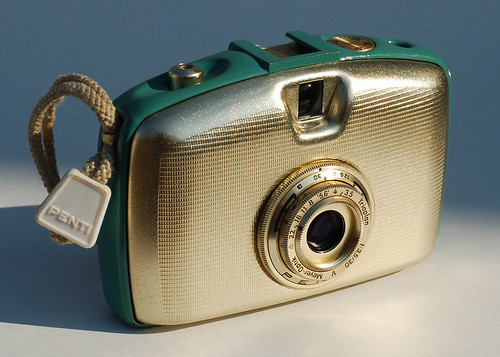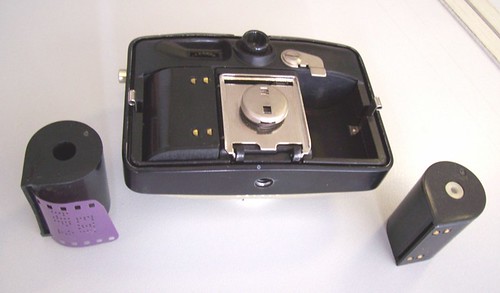Difference between revisions of "Penti"
m (→Links) |
m (grammar/spelling + minor detail) |
||
| Line 1: | Line 1: | ||
| − | {{Flickr image | + | {{Flickr image |
| image_source=http://www.flickr.com/photos/kratz/2241704075/in/pool-camerapedia | | image_source=http://www.flickr.com/photos/kratz/2241704075/in/pool-camerapedia | ||
| image=http://farm3.static.flickr.com/2262/2241704075_85bc5afcc1.jpg | | image=http://farm3.static.flickr.com/2262/2241704075_85bc5afcc1.jpg | ||
| image_align=left | | image_align=left | ||
| image_text=Penti with [[Meyer]] Trioplan lens | | image_text=Penti with [[Meyer]] Trioplan lens | ||
| − | }}{{br}} | + | }} |
| − | Once the | + | The '''Penti''' was made in East Germany by [[Welta]] from c.1959. It was available with a white, red or blue body. |
| + | {{br}} | ||
| + | Once the East German optical industry introduced a 35mm film load system concurrent to [[Agfa]]'s West German [[Rapid film]]. This '''SL-System''' (SL-System=Schnell-Lade-System : Fast Load System) used two equal cartridges, one loaded, the other empty. The [[film advance]] system shifted the film via the image plane from one cartridge into the other, image by image. | ||
{{Flickr image | {{Flickr image | ||
| image_source=http://www.flickr.com/photos/89864432@N00/245766133/in/pool-camerapedia | | image_source=http://www.flickr.com/photos/89864432@N00/245766133/in/pool-camerapedia | ||
| image=http://farm1.static.flickr.com/94/245766133_ff00f9198b.jpg | | image=http://farm1.static.flickr.com/94/245766133_ff00f9198b.jpg | ||
| image_align=left | | image_align=left | ||
| − | | image_text=SL film | + | | image_text=SL film cartridges and Penti's camera back opened<br>showing advance button pushed in on the left |
}}{{br}} | }}{{br}} | ||
| − | + | The '''Penti''' may have been the finest [[compact camera]] for this film load system, a viewfinder camera with a complete set of manual setting controls, all as rings around the lens: one for distance, one for aperture, and one for shutter speed. It could make 24 18×24mm exposures on one strip of 35mm film. There was a 1:3.5/30 lens, a [[Meyer]] Domiplan or a Meyer Trioplan, and a [[flash sync]]hronized [[leaf shutter]]. Its speciality was the long film advance button. Once pushed into the camera the film was advanced to the next frame. After exposure the button appeared again in full length so that forgetting film advance was never an issue with this camera. The button can be seen pushed in, in the photo of the back, above. | |
| + | [[Vitessa|Voigtländer's Vitessa]] had a similar feature. | ||
{{Flickr image | {{Flickr image | ||
| image_source=http://www.flickr.com/photos/89864432@N00/245758839/in/pool-camerapedia/ | | image_source=http://www.flickr.com/photos/89864432@N00/245758839/in/pool-camerapedia/ | ||
| Line 20: | Line 23: | ||
}}{{br}} | }}{{br}} | ||
In 1961 the '''Penti II''' was introduced by [[Pentacon]]'s predecessor ''VEB Kinowerke''. This version made it a real classic, combining the uniquely designed full featured viewfinder camera with viewfinder-controlled coupled match-needle [[selenium meter]]. It was produced until 1977. | In 1961 the '''Penti II''' was introduced by [[Pentacon]]'s predecessor ''VEB Kinowerke''. This version made it a real classic, combining the uniquely designed full featured viewfinder camera with viewfinder-controlled coupled match-needle [[selenium meter]]. It was produced until 1977. | ||
| + | The '''Penti I''' was similar to the II, but without the meter. | ||
==Links== | ==Links== | ||
| Line 25: | Line 29: | ||
*[http://yandr.50megs.com/welta/penti/penti.htm manual in German] | *[http://yandr.50megs.com/welta/penti/penti.htm manual in German] | ||
*[http://www.optiksammlung.de/Diverse/PentaconPentiII.html Penti II] at Optiksammlung [http://www.optiksammlung.de] | *[http://www.optiksammlung.de/Diverse/PentaconPentiII.html Penti II] at Optiksammlung [http://www.optiksammlung.de] | ||
| − | + | * [http://corsopolaris.net/supercameras/half/halformat1s.html Half Format Cameras 135] on [http://corsopolaris.net/supercameras/ Massimo Bertacchi's Innovative Cameras page] has all three Pentis | |
{{compact classic}} | {{compact classic}} | ||
| + | [[Category: P]] | ||
[[Category:SL-System]] | [[Category:SL-System]] | ||
[[Category:Welta]] | [[Category:Welta]] | ||
[[Category:Pentacon]] | [[Category:Pentacon]] | ||
[[Category:German half-frame viewfinder]] | [[Category:German half-frame viewfinder]] | ||
Revision as of 00:24, 25 April 2008

|
| Penti with Meyer Trioplan lens |
The Penti was made in East Germany by Welta from c.1959. It was available with a white, red or blue body.
Once the East German optical industry introduced a 35mm film load system concurrent to Agfa's West German Rapid film. This SL-System (SL-System=Schnell-Lade-System : Fast Load System) used two equal cartridges, one loaded, the other empty. The film advance system shifted the film via the image plane from one cartridge into the other, image by image.

|
| SL film cartridges and Penti's camera back opened showing advance button pushed in on the left |
The Penti may have been the finest compact camera for this film load system, a viewfinder camera with a complete set of manual setting controls, all as rings around the lens: one for distance, one for aperture, and one for shutter speed. It could make 24 18×24mm exposures on one strip of 35mm film. There was a 1:3.5/30 lens, a Meyer Domiplan or a Meyer Trioplan, and a flash synchronized leaf shutter. Its speciality was the long film advance button. Once pushed into the camera the film was advanced to the next frame. After exposure the button appeared again in full length so that forgetting film advance was never an issue with this camera. The button can be seen pushed in, in the photo of the back, above. Voigtländer's Vitessa had a similar feature.

|
| Penti II with selenium match-needle meter |
In 1961 the Penti II was introduced by Pentacon's predecessor VEB Kinowerke. This version made it a real classic, combining the uniquely designed full featured viewfinder camera with viewfinder-controlled coupled match-needle selenium meter. It was produced until 1977. The Penti I was similar to the II, but without the meter.
Links
- Welta Penti at Kurt Tauber's [1]
- manual in German
- Penti II at Optiksammlung [2]
- Half Format Cameras 135 on Massimo Bertacchi's Innovative Cameras page has all three Pentis
| Classic Compact Cameras |
|---|
| Canon IXUS | Minox 35 | Olympus XA | Penti |